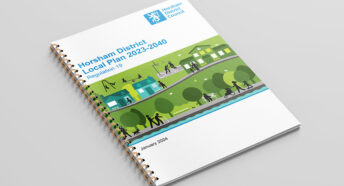Horsham District Update, September 2020
This update focuses on the Government’s proposed changes to planning rules and the planning system and the consequences for Horsham District. Analysis is work in progress and what is presented here is not exhaustive.
Radical proposals to change to the planning system, including the method by which housing targets are determined, and the role of local planning authorities, presented in two separate, but related documents, have been released by the Government for consultation (on 6 August):
‘Changes to the current planning system consultation on changes to planning policy and regulations’ closing 1 October. https://www.gov.uk/government/consultations/changes-to-the-current-planning-system
‘Planning for the Future, White Paper’ closing 29 October. https://www.gov.uk/government/publications/planning-for-the-future
The Government’s proposed new method for calculating housing targets would increase the minimum housing target for Horsham District from the current 800 houses per year to an unprecedented 1,715 per year, amounting to 30,870 over the period of HDC’s new local plan (yet to be approved).
1. Proposals are fundamentally flawed because:
1.1 The Government’s proposed changes neither acknowledge nor address the fundamental reality that developers and housebuilders will not build more houses than can be sold at an acceptable-to-them profit, and in the event of diminishing sales, due to economic downturn, will reduce build rates regardless of targets set by the Government for councils.
1.1.1 For example, Legal and General has delayed building houses North of Horsham, because of Covid-19 – which has caused it to review its “overall strategy for delivery at Horsham given the challenging situation we are currently all facing” (West Sussex County Times 28May20).
1.1.2 Note, too, Local Government Association Research, Feb 2020, found that: “more than a million homes granted planning permission since 2009/10 had not been built; The number of planning permissions granted for new homes has almost doubled since 2012/13, with councils approving nine in 10 applications; … councils recognise the shortage of housing and the need to build more homes, but the backlog of unbuilt homes shows the planning system is not a barrier to house building.” https://www.lgafirst.co.uk/news/a-million-homes-not-yet-built/
1.2 Instead, rather than challenge and call to account developers/builders when they reduce build rates, the Government prefers to blame and punish councils and communities, on the totally false premise that they, not developers, are responsible for shortfalls against targets – by disempowering them.
1.2.1 For example, the White Paper (page 10,11) misleadingly and unjustifiably criticizes councils for refusing planning applications, and for defending, refusals at Appeal – without recognizing that councils rightly refuse speculative applications for development of sites that have not been allocated in either local plans (for example HDC’s Horsham District Planning Framework) or Neighbourhood Plans, which do not conform with policies therein, or with the NPPF.
2. The proposals, if adopted, would reduce proportionally the delivery of genuinely ‘affordable’ homes.
3. Contrary to what is stated in the White Paper that “The change we will see – a more engaging, equitable and effective system” (page 24), the proposals will undermine local democracy and marginalise councils. The Town and Country Planning Association’s (TCPA) verdict is that:
4.
“The government’s planning White Paper, “will completely rewrite the English planning system. But while the TCPA is clear that the existing system needs to change, we are deeply concerned that the proposals will undermine local democracy, marginalise local councils and fail to achieve the kind of high quality places that the government is committed to delivering.”
“The complex proposals in the White Paper will move permission to the plan making stage, reducing democratic oversight and streamlining public consultations. At the same time the paper is weak on the contribution the planning system must make to health and well-being. It also puts back the date for achieving zero carbons homes to beyond 2025.” https://www.tcpa.org.uk/news/press-release-ripping-up-the-system-wont-build-the-homes- we-need-tcpa-responds-to-planning-for-the-future-white-paper
4.1 A huge unprecedented increase in housing targets now in prospect.
Proposals include replacing the ‘Standard Formula’ (imposed in 2008) with a new method, employing a reconfigured formula, which if adopted would result in hugely increased housing targets across Sussex. What these targets would be, and how they compare with existing targets, is detailed at:
5. New method would increase the minimum housing target for Horsham District from the current 800 houses per year to an unprecedented 1,715 per year.
5.1 Use of the new method would increase Horsham District’s ‘minimum housing need’ from the current local plan’s target of 800 homes per year to a stonking 1,715 homes per year, amounting to an unprecedented 30,870 over the period of HDC’s new local plan (yet to be approved).
5.2 Moreover, as is the case now, it would appear that where the capacity of a Local Planning Authority (LPA) to accommodate inflated housing targets is constrained – Adur, Brighton & Hove, Chichester and Crawley for example, the government is likely to allocate resultant shortfalls to neighbouring LPAs that in their view do have the capacity, including Horsham District. I refer readers to a revealing webinar, held 7 August, where a group of lawyers, including Mr Katowski QC, who Secretary of State Robert Jenrick MP, in his foreword to the White Paper, states is one of the ‘task force’ of experts who “have generously offered their time and expert advice as we have developed our proposals for reform”, discuss the White Paper: https://www.youtube.com/watch?v=fE6KD4K8ugk
6. To accommodate this enormous over-inflated target “We would need to build on every major housing site included in our recent Local Plan Regulation 18 consultation”
6.1 Cllr Claire Vickers, Horsham District Council’s Cabinet Member for Planning and Development, has advised that to accommodate this enormous over-inflated target “we would need to build on every major housing site included in our recent Local Plan Regulation 18 consultation” (West Sussex County Times, Aug 20th). These ‘major housing sites’, all of which are greenfield, are:
- Land at Adversane, West Chiltington Parish (Kingswood), Land East of Billingshurst (Little Daux),
- Land West of Billingshurst (Newbridge Park),
- Land at Buck Barn, West Grinstead (Weald Cross),
- Land West of Crawley, Rusper
- Land at Kingsfold, Warnham (North West Horsham), Land North East of Henfield (Mayfield),
- Land at Rookwood, Horsham,
- Land West of Southwater, Southwater.
(Horsham District Local Plan 2019-36 Public Consultation (Regulation 18), February 2020, pages 52-101)
6.2 Under the proposed new planning regime these ‘major housing sites’ would be deemed to be ‘Growth Areas’, for which see paragraph 8 below.
6.3 Note, too, that many of the smaller sites identified in the Local Plan 2019-36 (Regulation 18) Public Consultation would also be allocated for development within ‘designated Growth Areas’ and ‘Renewal Areas’, for which see paragraphs 7and 9 below.
7. Local Plans would identify three types of land.
7.1 The White Paper proposes that “Local Plans should identify three types of land – Growth areas suitable for substantial development, Renewal areas suitable for development, and areas that are Protected” (page 20):
“Simplifying the role of Local Plans, to focus on identifying land under three categories:
Growth areas suitable for substantial development, and where outline approval for development would be automatically secured for forms and types of development specified in the Plan;
Renewal areas suitable for some development, such as gentle densification; and
Protected areas where – as the name suggests – development is restricted. This could halve the time it takes to secure planning permission on larger sites identified in plans”.
7.2 Under the heading, ‘A Streamlined Development Management Process with Automatic Planning permission for Schemes in line with Plans”, White Paper Proposal 5 (page 34):
‘Areas identified as Growth areas (suitable for substantial development) would automatically be granted outline planning permission for the principle of development, while automatic approvals would also be available for pre-established development types in other areas suitable for building. There will therefore be no need to submit a further planning application to test whether the site can be approved. Where the Local Plan has identified land for development, planning decisions should focus on resolving outstanding issues – not the principle of development (page 34).
8. ‘Growth Areas’: of particular concern is the removal of democratic oversight and whether designated ‘Growth Areas’ would be placed under the control of Development Corporations. In effect government-appointed quangos that would not be accountable to communities.
8.1. The major planning sites identified and included Horsham District Local Plan 2019-36 Regulation 18 Consultation, listed at paragraph 6.1 above, would be designated ‘Growth Areas’ with automatic approval for development.
9. ‘Renewal Areas’: Whether councils would retain the right to refuse applications to develop sites that are not in the plan, and whether communities and residents would be able as now to actively engage in the decision-making process is far from clear. The apparent lack of clarity on this vital matter is itself cause for concern.
9.1 The White Paper (page 34) states that “In areas suitable for development (Renewal areas), there would be a general presumption in favour of development established in legislation (achieved by strengthening the emphasis on taking a plan-led approach, with plans reflecting the general appropriateness of these areas for development)”. Ostensibly, this would seem to reflect present practice.
9.2 Whether councils would retain the right to refuse applications to develop sites that are not in an adopted plan, and whether communities and residents would be able as now to actively engage in the decision-making process is far from clear. Clarity is essential.
9.3 The apparently deliberate lack of clarity on this vital matter is itself cause for concern.
10. ‘Protected Areas’
10.1 The White Paper states that “In areas where development is restricted (Protected areas) any development proposals would come forward as now through planning applications being made to the local authority (except where they are subject to permitted development rights or development orders), and judged against policies set out in the National Planning Policy Framework.”
10.2 The White Paper (page 29) states that “Areas that are Protected – this would include sites and areas which, as a result of their particular environmental and/or cultural characteristics, would justify more stringent development controls to ensure sustainability. This would include areas such as Green Belt, Areas of Outstanding Natural Beauty (AONBs), Conservation Areas, Local Wildlife Sites, areas of significant flood risk and important areas of green space. At a smaller scale it can continue to include gardens in line with existing policy in the National Planning Policy Framework. It would also include areas of open countryside outside of land in Growth or Renewal areas. Some areas would be defined nationally, others locally on the basis of national policy, but all would be annotated in Local Plan maps and clearly signpost the relevant development restrictions defined in the National Planning Policy Framework”.
11. Biodiversity and the natural environment at risk.
11.1 White Paper (pages 57, 58) ‘Proposal 16: We intend to design a quicker, simpler framework for assessing environmental impacts and enhancement opportunities, that speeds up the process while protecting and enhancing the most valuable and important habitats and species in England, includes the requirement that
“Processes for environmental assessment and mitigation need to be quicker and speed up decision-making and the delivery of development projects. The environmental aspects of a plan or project should be considered early in the process, and to clear timescales. National and local level data, made available to authorities, communities and applicants in digital form, should make it easier to re-use and update information and reduce the need for site-specific surveys.”
11.2 Site specific surveys of a site’s flora and fauna are needed to determine what species are present on a site that has been identified for development. This is because national and local level data sources cannot be relied upon to provide site-specific information on species present, up-to-date, or otherwise. County-level biodiversity record centres are dependent in the main on sporadic inputs from interested members of the public, not systemic and comprehensive surveys.
11,3 Reducing or removing the need for site specific surveys of development sites would undoubtedly have catastrophic consequences for flora and fauna, and biodiversity.
12. Debated in Parliament 7 September 2020: ‘Housing Developments: West Sussex’ https://hansard.parliament.uk/commons/2020-09-07/debates/0EDBB630-901A-4646-84D9-F51306027BCB/HousingDevelopmentsWestSussex
12.1 Andrew Griffith MP (Arundel and South Downs), who called the debate, aptly described the ‘new method’ as “a ‘mutant algorithm’ cooked up in the wet market of Whitehall”. He explained that the proposed new method is ‘fundamentally flawed’ because:
“it appears to be entirely blind to geography, which is not a great look for a planning system. If, as in West Sussex, much land is physically incapable of being developed or is protected in law, the algorithm appears to completely ignore this”.
And “the standard method algorithm is backward looking and self-perpetuating; unlike the famous investment disclaimer, past performance here is treated as entirely a predictor of future success. Districts with high rates of house building in the past are assumed to continue that into perpetuity, so this fatally undermines any opportunity to level up away from the over-heated south-east of England”.
He noted, too, that the ‘mutant’ algorithm “must only work in dry weather”, as much of his constituency “lies on the floodplains of the Rivers Arun, Adur and Rother, something that even a cursory look at the lacework of blue lines on an Ordnance Survey map would reveal”.
To watch/listen to a recording of this important debate, click on:
https://www.parliamentlive.tv/Event/Index/ae0bccf3-828e-48ea-b050-0c8dd7206ae4
Slide the Black Spot on the timer bar to around 20:55 and then Play. Andrew Griffith starts speaking within a minute or two.
13. What you can do:
Please examine and respond to the consultations:
‘Changes to the current planning system consultation on changes to planning policy and regulations’ closing 1 October. https://www.gov.uk/government/consultations/changes-to-the-current-planning-system
‘Planning for the Future, White Paper’ closing 29 October. https://www.gov.uk/government/publications/planning-for-the-future
Write to your MP, and your District Councillors. The MP for Horsham, Mr Jeremy Quin:
Email jeremy.quin.mp@parliament.uk Copy to office@horshamconservatives.com or via https://www.jeremyquin.com/contact
Or write to him c/o his constituency office: Gough House, Madeira Avenue, Horsham, West Sussex RH12. Telephone 01403 210600
The MP for Arundel and South Downs, Mr Andrew Griffith.
Write to him:
MP for Arundel & South Downs House of Commons, London SW1A 0AA
Or email: Andrew@GriffithMP.com
Dr Roger F Smith
Trustee CPRE Sussex
CPRE Sussex’s Horsham District representative/leader and Protect Sussex Planning Group Chair
11 September 2020




